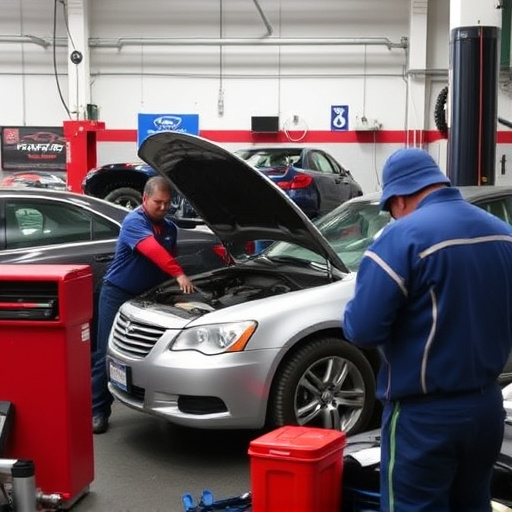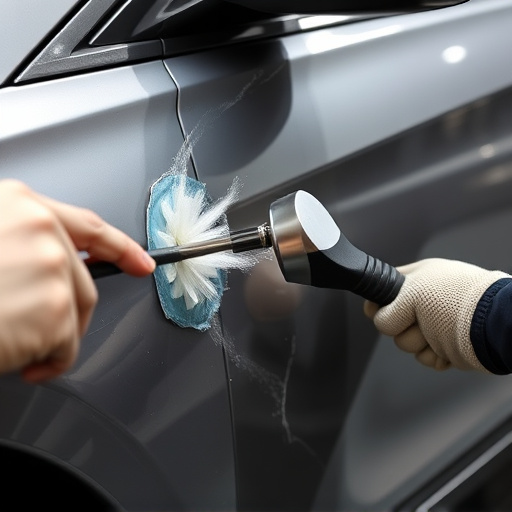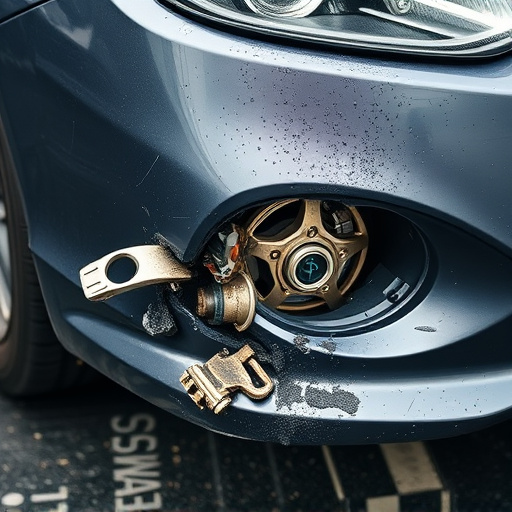Frame Repair for Insurance: Navigating State Regulations for Compliance

Understanding state regulations for frame repair is crucial for insurance claims. Each state sets st…….
In an era defined by complex global networks and evolving risk landscapes, the insurance industry has embraced innovative strategies to assess, manage, and mitigate risks effectively. One such strategy that has garnered significant attention is frame repair for insurance—a specialized approach that focuses on restoring and reinforcing the structural integrity of insured properties, particularly after damage or deterioration. This article delves into the intricacies of frame repair within the insurance sector, exploring its definition, global impact, economic implications, technological innovations, regulatory frameworks, challenges, successful case studies, and future prospects. By the end, readers will grasp the critical role this practice plays in shaping the resilience and sustainability of our built environment.
Frame repair for insurance is a specialized service that involves the meticulous restoration and reinforcement of the structural frame of insured buildings or structures. The structural frame, comprising load-bearing walls, beams, columns, and other critical components, is the backbone of any structure. When this framework sustains damage due to natural disasters, aging, or human activity, it can compromise the overall stability and safety of the building.
The primary objectives of frame repair in an insurance context are:
Historical Context: The concept of frame repair gained prominence in the 20th century as construction methods evolved and buildings became more complex. With increasing urbanisation and the rise of modern architecture, ensuring the longevity and safety of structures became a paramount concern. Over time, insurance companies integrated frame repair into their risk assessment and claim settlement processes, recognising its importance in property conservation and community resilience.
The influence of frame repair for insurance is not confined to any particular region or culture; it has permeated diverse global markets, albeit with unique variations. Here’s a glimpse into some key trends and regional dynamics:
North America: In the United States and Canada, frame repair services are well-established, driven by stringent building codes and a robust insurance sector. The market is characterised by advanced technology and a strong focus on safety standards. For instance, the California Earthquake Authority (CEA) offers programmes that incentivise homeowners to retrofit their older homes to enhance seismic resilience, exemplifying a proactive approach.
Europe: European countries, particularly those in Western Europe, have seen a rise in frame repair activities due to ageing infrastructure and stringent environmental regulations. Germany, known for its robust construction standards, has implemented strict building codes that promote structural integrity, leading to increased demand for frame repair services.
Asia Pacific: The Asia Pacific region presents a diverse picture, with rapid urbanisation driving the need for frame repairs in older urban areas. Japan, for instance, has an advanced system of earthquake insurance that encourages frame repair and reinforcement as a means of mitigating seismic risks. In contrast, countries like Australia are focusing on resilient construction practices to prepare for natural disasters.
Emerging Markets: Cities in Latin America, Africa, and the Middle East are experiencing rapid growth, leading to increased demand for affordable housing and infrastructure. This presents both opportunities and challenges for frame repair services, as these regions strive to balance economic development with structural integrity.
The economic landscape of frame repair for insurance is shaped by several key factors:
| Factor | Impact |
|---|---|
| Market Size: The global insurance industry, valued at over $1.5 trillion in 2021, provides a substantial foundation for frame repair services. As the middle class expands globally and urbanisation accelerates, the demand for property insurance—and consequently, frame repair—is expected to rise. | Growing market size translates into increased investment opportunities and potential for economic growth in the frame repair sector. |
| Per Capita Income: Higher per capita income levels are associated with stronger insurance penetration and a greater emphasis on home maintenance and safety. This trend drives demand for comprehensive property insurance policies, including frame repair coverage. | In countries with rising incomes, such as China and India, the need for frame repair services is likely to increase, creating new business avenues. |
| Building Stock: The age and condition of existing buildings significantly influence the demand for frame repairs. Older urban areas often require more extensive maintenance, whereas newer constructions may be less prone to structural issues. | Regions with older building stock, such as many European cities, present consistent long-term opportunities for frame repair service providers. |
| Regulatory Environment: Government policies and regulations play a crucial role in shaping the insurance sector and its associated services. Incentives, subsidies, or mandatory requirements for structural reinforcement can boost demand for frame repairs. | For example, Japan’s comprehensive earthquake insurance programme encourages citizens to invest in frame repair, thereby strengthening the market. |
Technological innovations have significantly enhanced the efficiency, accuracy, and safety of frame repair processes:
3D Modelling and BIM (Building Information Modelling): These technologies enable detailed digital representations of buildings, allowing insurers and contractors to visualise structural elements, plan repairs, and manage project timelines more effectively.
Drone Inspection: Drones equipped with high-resolution cameras and sensors can access hard-to-reach areas, providing bird’s-eye views for thorough building inspections. This technology reduces the time and cost associated with traditional inspection methods.
Advanced Materials: Newer materials like fibre composites and advanced steel alloys offer superior strength-to-weight ratios, making them ideal for reinforcing structural components while minimising additional weight.
Digital Documentation: Cloud-based platforms facilitate digital documentation of repair processes, allowing real-time data sharing between insurers, contractors, and policyholders. This streamlines claim processing and enhances transparency.
Regulatory frameworks play a pivotal role in governing frame repair practices and ensuring consumer protection:
Building Codes: Local and national building codes dictate minimum structural standards, including requirements for frame repair and reinforcement after damage or alterations. Compliance with these codes is mandatory, and non-adherence can lead to legal consequences.
Insurance Policies: Property insurance policies often include specific clauses related to frame repair, detailing the responsibilities of both insurers and policyholders. These policies may offer incentives or require certain repairs to maintain coverage.
Government Incentives: Some governments provide financial incentives or subsidies for citizens who invest in structural reinforcement, encouraging proactive measures to enhance building safety.
Professional Associations: Industry bodies and professional associations set standards and guidelines for frame repair practices, ensuring quality and consistency. These organisations also lobby for regulatory changes that support the industry.
Despite its benefits, frame repair for insurance faces several challenges and criticisms:
Cost and Accessibility: Frame repairs can be expensive, particularly in regions with limited access to skilled labour or specialised materials. This may deter policyholders from pursuing necessary repairs, especially if they lack comprehensive insurance coverage.
Regulatory Compliance: Navigating complex building codes and regulatory requirements can be cumbersome for contractors and insurers alike. Inconsistent enforcement of these rules across jurisdictions adds to the complexity.
Public Awareness: Many homeowners are unaware of the importance of frame repair or the specific terms and conditions of their insurance policies, leading to potential gaps in claim processing and repair implementation.
Natural Disaster Variability: The frequency and intensity of natural disasters vary globally, affecting the demand for frame repair services unpredictably. This volatility can strain resources and capacity in certain regions.
Actionable Solutions:
Japan, prone to severe earthquakes, has implemented a comprehensive earthquake insurance programme that encourages frame repair and reinforcement. The government offers incentives, such as reduced premiums and subsidies for structural upgrades. This initiative has led to widespread adoption of seismic retrofitting, resulting in significantly fewer fatalities and property losses during recent earthquakes. The success lies in the combination of mandatory requirements, financial incentives, and public awareness campaigns.
Lessons Learned:
Berlin, Germany, presents a unique challenge due to its vast stock of historic buildings. The city has successfully navigated the restoration of these structures while meeting modern safety standards. The Berlin Senate introduced a heritage conservation programme that provides funding and technical support for frame repairs while preserving architectural integrity. This approach has not only revitalised the built environment but also attracted tourists, fostering economic growth.
Lessons Learned:
The future of frame repair for insurance is poised for growth and innovation, driven by several emerging trends:
Digitalisation and IoT (Internet of Things): The integration of IoT sensors into buildings will enable real-time monitoring of structural health, triggering proactive maintenance alerts. This data-driven approach can optimise repair schedules and resource allocation.
Green Building Practices: As sustainability becomes a priority, frame repairs will increasingly incorporate eco-friendly materials and methods, aligning with green building standards.
Remote Repair Technologies: Advancements in robotics and remote control technologies may enable certain frame repairs to be conducted remotely, reducing on-site risks and costs.
Dynamic Pricing Models: Insurance providers might adopt dynamic pricing based on real-time risk assessment, including structural integrity data gathered from IoT devices.
Frame repair for insurance is more than just a service; it is a strategic approach to fostering community resilience and safeguarding valuable assets. As the global landscape continues to evolve, this practice will play an increasingly critical role in mitigating risks associated with natural disasters, ageing infrastructure, and changing environmental conditions. By embracing technological advancements, simplifying regulations, and promoting public awareness, the insurance industry can drive positive change in the built environment.
Q: What is the primary purpose of frame repair in an insurance context?
A: The primary purpose is to restore and reinforce the structural integrity of insured properties after damage or deterioration, ensuring safety and mitigating future risks.
Q: How does frame repair differ from regular maintenance?
A: While regular maintenance focuses on preventive care, frame repair addresses structural issues caused by damage, ageing, or environmental factors, often requiring more extensive work.
Q: Can homeowners refuse to undergo recommended frame repairs as per their insurance policy?
A: It depends on the specific policy terms. Homeowners are generally required to undertake reasonable repairs to maintain coverage. Refusal may lead to policy cancellations or non-claim settlements.
Q: Are there any government initiatives to support frame repair for low-income homeowners?
A: Yes, many governments offer incentives, grants, or affordable loan programmes to encourage essential frame repairs among low-income households.
Q: How can technology improve the efficiency of frame repair processes?
A: Technologies like BIM, drone inspections, advanced materials, and digital documentation streamline project management, enhance accuracy, and reduce costs associated with traditional methods.

Understanding state regulations for frame repair is crucial for insurance claims. Each state sets st…….

Successful frame repair for insurance claims starts with a detailed vehicle damage assessment by ski…….

Insurance policies offer varying frame repair coverage after car accidents. To maximize benefits, po…….

Frame repair for insurance claims involves specialized services from body shops. Skilled technicians…….

Insurers require laser measurements for severe frame repair claims to ensure accurate, safe repairs……..

Insurance companies mandate thorough photography before frame repair to accurately document damage f…….

When filing insurance claims for frame repair, only approved or certified auto body shops should be…….

Frame repair for insurance is a critical process for assessing and restoring damaged vehicles, ensur…….

Understanding frame repair process for insurance claims is crucial. Frame damage requires detailed e…….

Frame repair for insurance claims is vital for vehicle safety and aesthetic restoration after accide…….